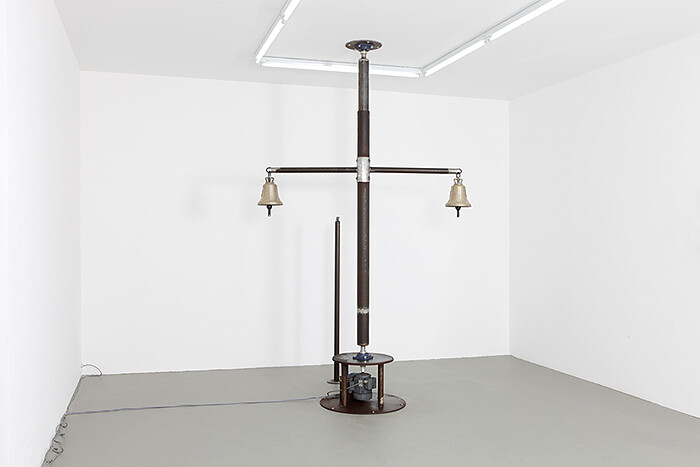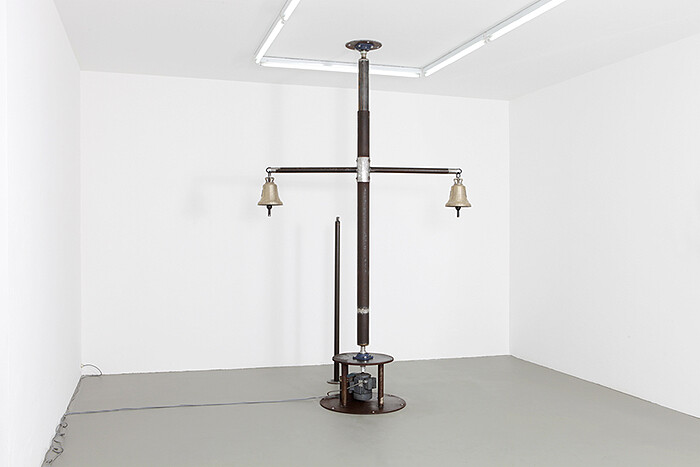“The Bell Show” and “The Gong Show,” curated by Dieter Roelstraete, is a two-fold exhibition marking the second collaboration between adjacent galleries in the middle of Berlin Tiergarten, Micky Schubert and Lüttgenmeijer. Illustrating their titles, the shows respectively feature works concerning either gongs or bells.
In Lüttgenmeijer’s “The Bell Show” some works are grandiose, like the Teutonic Vertigo-Glocken (Vertigo Bells) (1997) by Carsten Höller. Some are disarmingly tender like The Step When I Forget What I Thought My Calling Was (2011) by Hadley+Maxwell, who also did the most allegorical work of the show, a cryptic memento mori, Away, as in “For Passing Away is the Figure of this World” (2010). Other works appear to be ironic juxtapositions of heroism and advertising imagery, like that of Ruth Ewan or Lothar Hempel. The selection has a histrionic and excessive touch.
“The Gong Show,” just next door, seemed to gather together works of refined containment and minimal nuance. Most are literal, like Wolfgang Tillmans’s Gong (2007); or Zin Taylor’s Black Stool (Darkened Lump) and Black Stool (Nub of Rug) (2011). A few are archival, like Pierre Bismuth’s A Brief Historical Survey of Continuity in the J. Arthur Rank Organization (2011) or Mark Soo’s Noisemaker No. 1 (2008). Others are befuddling, like Annika Larsson’s Owl Saying Gong, Adorno Saying Gong, and Stork Saying Gong (all 2011) and Karl Holmqvist’s Gongs and Bells (2011)—which are also the only works addressing sound as a visual phenomena.
Both shows share an uncanny silence, only sporadically interrupted by the tolling of Höller’s mechanical bell ring.
The Bell/Gong shows are complemented by two ancillary publications in which the curator, correspondingly, lists a summation of gong usage in contemporary music and some assorted thoughts on bells, mostly revolving around Tarkovksi’s Andrej Rublev. The lists are by no means exhaustive but rather embrace their status as anecdotes or fragmentary notes that work in parallel to the objects displayed while abstaining to reflect upon their content. Two levels of reading become apparent; thus, one denies what the other affirms. For though the texts refuse to perform an ordinal function, the nominal division alone establishes a dualism between “gong” and “bell”; which, in turn, conjures yet another dualism between East and West.
To complicate matters, there appears to be an unresolved tension between the cool detachment intended and a yearning for denouement. Either that of a Buddhist temple or an Orthodox church, both gong and bell are pregnant objects, denoting liturgy, the ritualization of everyday life, and an experience of communality. Props of a world prior to its disenchantment, bells and gongs remain foreign to secularization or to the protestant privatization of religion. However literally one seeks to treat them, bells and gongs remain signifiers of nostalgia. Here, the show relapses into the conventions of sentiment it set out to avoid.
Nostalgia was once considered a medical condition. The term was coined in 1688 to refer to the modern malaise of proletarianization: the uprooting of peasants from their ancestral lifestyles to become armies of factory workers or armies proper. One could say that a spatial axis has been internalized into a temporal mode, a lost place becomes a bygone time. Whereas Modernism loathed such inclinations and communism sought to cure the ills of modernity with chants of a glorious tomorrow, capitalism embraced the logic of longing: the past as a panacea. Nostalgia resurfaced in art as a feature of the “dominant cultural logic of late capitalism” (Jameson), which Clive Owens described as “postmodernism”—a “conviction of the remoteness of the past,” be it recent or distant and a “desire to redeem it for the present.” Such is the allegorical endeavor of these paired shows, to puzzlingly gaze upon bells and gongs with the wish that they disclose their meaning. Albeit, remoteness is all they signify.
Retrospections notwithstanding, the present is gaining momentum. While I write this article, from Egypt to Wisconsin, history is making a furious comeback. We are not at the endgame of ideology after all, thus this might well be one of the last postmodern moments we will bear witness to. “Ask not for whom the bell tolls, it tolls for thee”.…







